

British writer and artist. M.poets. William Blake. William Blake. William Blake (28 November 1757 – 12 August 1827) was an English poet, painter, and printmaker.
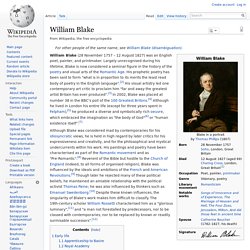
Largely unrecognised during his lifetime, Blake is now considered a seminal figure in the history of the poetry and visual arts of the Romantic Age. His prophetic poetry has been said to form "what is in proportion to its merits the least read body of poetry in the English language".[2] His visual artistry led one contemporary art critic to proclaim him "far and away the greatest artist Britain has ever produced".[3] In 2002, Blake was placed at number 38 in the BBC's poll of the 100 Greatest Britons.[4] Although he lived in London his entire life (except for three years spent in Felpham),[5] he produced a diverse and symbolically rich oeuvre, which embraced the imagination as "the body of God"[6] or "human existence itself".[7] Early life[edit] 28 Broad Street (now Broadwick Street) in an illustration of 1912.
Blake was born here and lived here until he was 25. Apprenticeship to Basire[edit] Francis of Assisi. Catholic saint and founder of the Franciscan Order Saint Francis of Assisi (Italian: San Francesco d'Assisi, Latin: Sanctus Franciscus Assisiensis), born Giovanni di Pietro di Bernardone, informally named as Francesco (1181/1182 – 3 October 1226),[2] was an Italian Catholic friar, deacon and preacher.
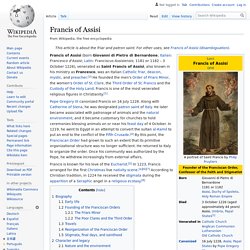
He founded the men's Order of Friars Minor, the women's Order of Saint Clare, the Third Order of Saint Francis and the Custody of the Holy Land. Geoffrey Chaucer - Books, Poems & Facts. English poet Geoffrey Chaucer wrote the unfinished work, The Canterbury Tales.
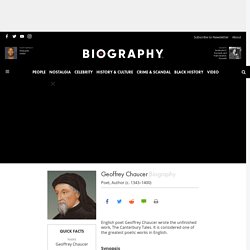
It is considered one of the greatest poetic works in English. Synopsis Poet Geoffrey Chaucer was born circa 1340 in London, England. In 1357 he became a public servant to Countess Elizabeth of Ulster and continued in that capacity with the British court throughout his lifetime. The Canterbury Tales became his best known and most acclaimed work. Geoffrey Chaucer. Geoffrey Chaucer. English poet and author Arms of Geoffrey Chaucer: Per pale argent and gules, a bend counterchanged Arms of Chaucer (modern), as adopted by his son Thomas Chaucer and as later quartered by his heirs de la Pole Dukes of Suffolk: Argent, a chief gules overall a lion rampant double queued or.
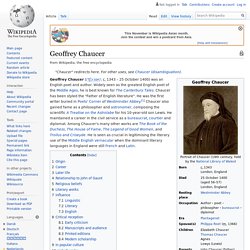
Pierre Teilhard de Chardin. Pierre Teilhard de Chardin SJ (French: [pjɛʁ tejaʁ də ʃaʁdɛ̃] ( listen ); 1 May 1881 – 10 April 1955) was a French idealist philosopher and Jesuit priest who trained as a paleontologist and geologist and took part in the discovery of Peking Man.
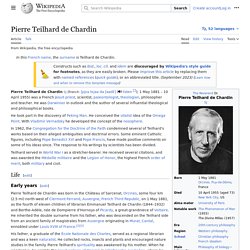
He conceived the vitalist idea of the Omega Point (a maximum level of complexity and consciousness towards which he believed the universe was evolving), and he developed Vladimir Vernadsky's concept of noosphere. Although a monitum was issued in regard to some of Teilhard's ideas, he has been posthumously praised by Pope Benedict XVI and other eminent Catholic figures, and his theological teachings were cited by Pope Francis in the 2015 encyclical, Laudato si'. The response to his writings by evolutionary biologists has been, with some exceptions, decidedly negative, although recently some have written more positively about Teilhard's ideas. Life[edit] Early years[edit] Academic career[edit] Heidegger man as being towards death. Heideggerian terminology. Martin Heidegger, the 20th-century German philosopher, introduced to the world a large body of work which intended a profound change of direction for philosophy.

Such was the depth of change that he found himself needing to introduce a number of neologisms and adapted vocabulary, often connected to idiomatic words and phrases in the German language. Two of his most basic neologisms, present-at-hand and ready-to-hand, are used to describe various attitudes toward things in the world. For Heidegger, such "attitudes" are prior to, i.e. more basic than, the various sciences of the individual items in the world. Science itself is an attitude, one that attempts a kind of neutral investigation. Other related terms are also explained below. Heidegger, Martin. Martin Heidegger is widely acknowledged to be one of the most original and important philosophers of the 20th century, while remaining one of the most controversial.
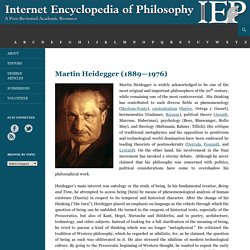
His thinking has contributed to such diverse fields as phenomenology (Merleau-Ponty), existentialism (Sartre, Ortega y Gasset), hermeneutics (Gadamer, Ricoeur), political theory (Arendt, Marcuse, Habermas), psychology (Boss, Binswanger, Rollo May), and theology (Bultmann, Rahner, Tillich). His critique of traditional metaphysics and his opposition to positivism and technological world domination have been embraced by leading theorists of postmodernity (Derrida, Foucault, and Lyotard). On the other hand, his involvement in the Nazi movement has invoked a stormy debate. Although he never claimed that his philosophy was concerned with politics, political considerations have come to overshadow his philosophical work.
Heidegger’s main interest was ontology or the study of being. Table of Contents 1. 2. 3. 4. 5. Martin Heidegger. Martin Heidegger (German: [ˈmaɐ̯tiːn ˈhaɪdɛɡɐ]; 26 September 1889 – 26 May 1976) was a German philosopher, widely seen as a seminal thinker in the Continental tradition, particularly within the fields of existential phenomenology and philosophical hermeneutics.

From his beginnings as a Catholic academic, he developed a groundbreaking and widely influential philosophy. His relationship with Nazism has been a controversial and widely debated subject. For Heidegger, the things in lived experience always have more to them than what we can see; accordingly, the true nature of being is “withdrawal”. The interplay between the obscured reality of things and their appearance in what he calls the “clearing” is Heidegger's main theme.